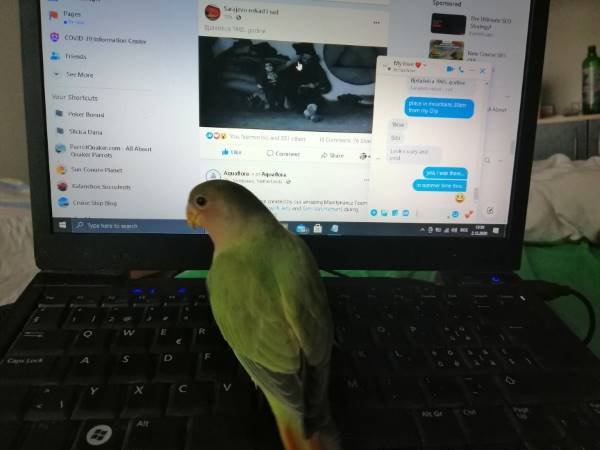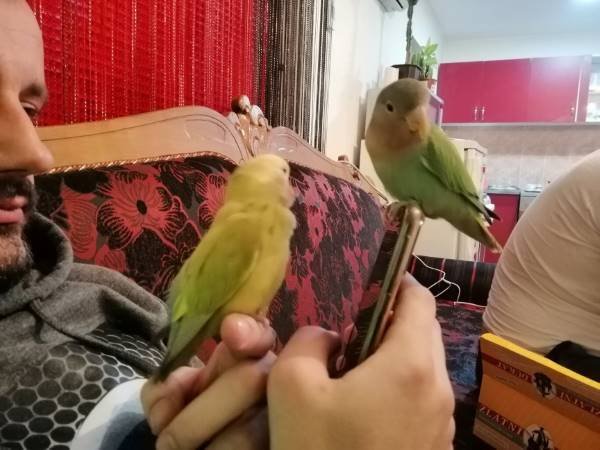Lovebirds are without a doubt one of nature’s most expressive types of parrot. They’re one of the most common species to see in the homes of bird enthusiasts, and for good reason. These endearing critters are fantastic, interesting house pets because they are lovely and intelligent, and they also seem to have a mind of their own which they will regularly display through their prominent songs and melodies, as well as in their movement patterns and physical body language.
You may have heard lovebirds making various different types of noises before, and maybe you’ve caught yourself wondering if there was any real meaning behind these noises, or if it’s all just arbitrary. Well, amazingly enough, lovebirds actually have distinct ways that they can communicate with each other through not only the noises they make but through their body language as well.
In this article, I will briefly go over some of the most common behaviors that lovebirds have been known to use, as well as the respective meaning behind each of these behaviorisms both for verbal and physical communication.
Common Lovebird Sounds
These are some of the most common sounds you will hear lovebirds making. These sounds may or may not be accompanied by physical body language that can give you a better idea of what they are trying to tell you. It’s important to take their physical mannerisms into account too, which we will cover in the section after this one.
Lovebird Chirping
When your lovebird chirps, it is usually a sign that they are very relaxed, and they want to communicate with you or another bird. Usually, they make this sound after having a good meal or just before falling asleep. It can be morning sound or any time they decide to rest and relax. Sometimes this sound can convert into mimicking other sounds or even talking.
Lovebird Singing sounds
Singing may appear similar to chirping, and there may be some overlap between the two. It’s generally like chirping, except with more energy and volume.
When you hear your lovebird singing in an upbeat way like this it is a good sign that they are in generally high spirits and that they feel like, well, singing! The expression for humans exists that goes “I’m so happy I could sing”. Lovebird singing sounds are most often a way to “call” and communicate with other Lovebirds. If you own a pair of Lovebirds they will often sing together. If you own a single lovebird they might use singing sound to call human, or just notify about his/her presence. My Female lovebird uses this call even if she hears sparrows outside.
Lovebird “Alarm call” sound
At beginning of the video above you can hear the sound of an alerted Lovebird. That is sound lovebirds use when they are unsure about objects they see. As they are naturally prey animals they can get Alarmed about anything in their surrounding. Most animals in their wild surroundings consider them food. So being on constant alert helps them in nature. One in the video above is probably just excited about camera i just put in front of cage. As soon as she figures out camera is not a threat, she changes her call to singing/chirping sounds.
Lovebird Growling or Hissing sound
While this might not sound like a typical growl you would expect from an animal like a dog defending its territory or master, lovebirds also have their own version of a “growl”, although their usage is slightly different.
Unlike with larger animals, when lovebirds growl it’s normally a sign that they are annoyed or irritated with something, and they might be provoked to attack whatever the source of their irritation is. You might hear your lovebird making this sound if it’s getting restless and trying very hard to break out of its cage using its beak, or if it’s put in a different stressful situation. Maybe you are trying to gently pet your lovebird too often. Or maybe you’ve paired up your lovebird with another bird that isn’t getting along with them.
Also if you check video above you can notice distinct hissing/growling of unhappy bird. My girl is just not happy I am coming to her’s territory. Lovebirds are famous as very territorial. Especially if it is a case of female in breeding season
Lovebird Crooning
If you have two lovebirds that have a good relationship with each other, there’s a good chance you might see or hear them doing some crooning. These soft happy noises are usually done alongside physical body language such as nuzzling up next to you or another bird for physical contact.
This is similar to how you might notice a cat purring when it’s happy, and coming up to you because it wants you to pet it. Birds are similar in that they crave physical contact and affection in the same way.
Common Lovebird Body Language
Birds are not limited to just sounds that they can make. Just like people, a huge amount of the communication you can expect to see from your lovebird is going to be through their physicality, or lack thereof. For this section I’m going to cover some of the typical body language signs you might see from your lovebird.
Keep in mind that some body language might change the context of some of the sounds your lovebird will make.
Scared/Sad body language
If you have just purchased a lovebird for your home, there is a decent chance your new bird may be scared of the new environment that they’re being placed into. This is relatively normal behavior for your lovebird to show in this situation. After all, you’re the giant in this situation; the lovebird is so small in comparison, so it’s normal that it might feel a little bit helpless at the start.
When scared, the lovebird will often try to stay low to the ground, and keep its wings close to itself. If you pick up your lovebird and attempt to move around with it while it’s scared, you might notice the lovebird lowering its legs closer to where they’re perched.
This is normal defensive behavior. From the bird’s perspective, anything could happen in the next few seconds, and they feel the need when scared to always be prepared to take flight and escape any dangers that might present themselves. Even if you’ve clipped your lovebird’s wings, they may still display this behavior. A bird that isn’t scared will typically feel comfortable moving around on your arm after you pick them up.
Sad behavior from birds is very similar, although usually with less overall movement. A sad lovebird will typically lower its head and eyes and start looking at the ground more often than usual.
If your lovebird is sad or upset you may notice them not moving around very much, or banging around in their cage like crazy. Birds get bored too, so make sure you have something for them to play with so they don’t get too restless. You may also want to check to see if your lovebird is eating their food properly, or if they aren’t touching it for some reason. There may be a chance your bird is sick if they don’t touch their food and if they aren’t behaving like their usual self.
Lovebirds under normal circumstances should adjust to their new environment in a matter of days, although sometimes it may take as long as two weeks and this can vary from bird to bird.
If you notice your lovebird is still displaying signs of being scared of something, you may want to investigate its environment. Make sure their cage is away from any other animals you may be keeping, and keeping the cage in a quieter area may help alleviate stress as well. Consider covering your cage at night with a thin sheet of some kind if your cage’s area is exposed to a lot of light or outside movement when your bird is trying to sleep.
Happy/Content Lovebird
Singing isn’t the only behavior they display when they’re feeling the good vibes. If you have toys positioned on or around your cage you may notice your lovebird jumping around on them, or maybe gnawing at them if it’s something soft for the bird to chew on.
And like we said previously, if you want to carry around a lovebird that’s happy and energetic, you should expect the bird to be very eager to explore your entire arm, if not the rest of your body as well. To the bird, your entire body is like a plaything to it, and most lovebirds will enjoy the outing, so long as you aren’t taking them out of their normal environment too often. Keep an eye out for signs that the bird may be getting annoyed with you, such as them pecking at your skin aggressively, or if you hear them growling at you.
Aggressive/Territorial Lovebird
Lovebirds typically display aggression towards other birds when they feel their space is being encroached on or invaded in some other way.
Imagine your bird is a moody teenager. You would understand why a teenager might lash out at you if you force them to keep their room door open, right? Birds, just like people, really value their territory and their own personal space. You can expect aggressive birds to make direct eye contact with the threat and attempt to become as large as possible by tensing their muscles and puffing their chest out.
We have a big article about Lovebird Biting behavior here.
Lovebird’s body language that follows aggressive behavior is:
- Fluffed feather because Lovebird is trying to look bigger.
- Keeping head and beak low to the ground.
- Fake leap towards an object that invokes aggression.
- And strong bite at end. Even though they are a smaller type of parrots, they have strong muscles of head, and they can deal strong bite.
Most often this behavior is shown with territorial birds.Also more often with females than males.
Conclusion
Despite their noisy reputation, lovebirds are actually very intentional when it comes to their communication. Everything the lovebird does, from the sound it makes to the body language it displays, to how often it decides to speak to you, all these things will come together to inform you of what your bird wants from you in that moment. Sometimes your lovebird just wants to talk about their day and relax. Other times your lovebird may be trying to get you to fix something that’s bothering them.
With enough time around your birds, it will eventually become second nature to what your lovebird is thinking about. Just like with human beings, communication is key, so make sure you’re listening to your lovebird’s needs and you can be sure that your bird will be much happier overall after having been properly listened to.




